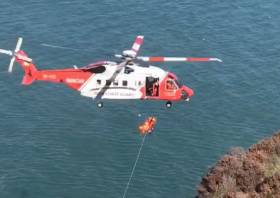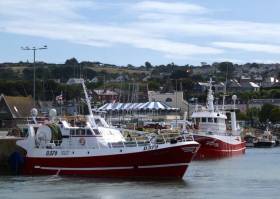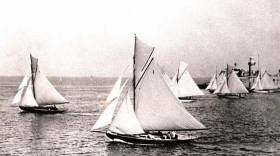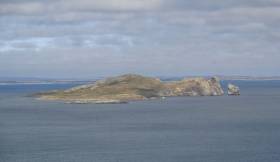Displaying items by tag: Howth
Howth’s Balscadden Bay Evokes the Ghosts of W B Yeats and The Ginger Man in Tuesday’s Super-Moon
We’ll begin by making it clear that this remarkable image of Tuesday night’s super-moon over Balscadden Bay in Howth was taken at 2041hrs by a Howth resident within the prescribed two kilometres of her residence, using a carbon-neutral means of transport. And while the moon itself and the cloud with it have probably caused rumours of Unidentified Flying Objects (for they’re regular visitors to the peninsula and had scheduled flights to Mars before the lock-down), another area of interest is the high level of literary associations within this one remarkable photo.
For the little cliffside house at centre has a plaque which claims association with the Yeats family. But while the poet’s often penniless father John Butler Yeats did indeed briefly accommodate his family there around 1880, their two year stay in Howth in the early 1880s was in the harbour-side house where traditional boat enthusiast Mick Hunt and his wife Elaine now live. W B Yeats' sisters remembered it as only crowded, cold and damp, but as anyone who has visited the house today will know, Mick has achieved a miracle of transformation to make it a warm, dry, airy and welcoming place.
But in any case, the more immediate association of that little cliffside house, or the next one along to the right of the photo, is that Gaynor Crist, the original for J P Donleavy’s Ginger Man, lived there for a while in the 1940s when he was a GI Bill student at Trinity College. Many of us find a re-reading of The Ginger Man, so symbolic of our younger days, to be a rather depressing experience today, but nevertheless it reveals that while ensconced on the Balscadden cliffs in a rented house in which the waves moaned and crashed in the cliff caves close underneath, the Ginger Man found he was completely broke and very hungry.
But he noted that one of the beds was covered in a pink blanket. So he took the scissors from the kitchen and cut the blanket into strips, one of which he then modified into a passable resemblance of a scarf. As he favoured tweed jackets and rustic apparel, with this scarf he immediately became the very image a a Trinity sporting pink (the highly-respected TCD equivalent of an Oxford blue), and was thus able to stride with confidence down the the Balscadden Road and along the harbour front to Findlater’s splendid grocery emporium (these days it's Michael Wright’s gastro-pub of the same name), wherein he had no trouble running up a credit list as long as your arm of a substantial and comprehensive order of high quality victuals, which were then promptly delivered to Balscadden by one of the familiar Findlater vans.
It is not thought that the bill was ever paid…..As for Findlater’s in Howth, it is written for ever into local sailing history, for when the Howth 17 class got going in 1898, it was in their sailing instructions that “The time (for starts) to be taken from Findlater’s clock”.
Howth Lifeboat Rescues Two From Rocks Cut Off By Tide
Howth RNLI launched their Inshore lifeboat yesterday (Tuesday 3 March) to rescue two people stranded on rocks in Balscadden Bay.
Pagers sounded at 1.58pm after a call was placed to the coastguard reporting two people stranded at the base of the cliffs just east of Howth’s East Pier.
Volunteer crew members launched the inshore lifeboat within 12 minutes of getting the call and proceeded to the area, where they quickly located the casualties.
Both were taken aboard the lifeboat and checked over and were found to be unharmed and in good spirits as they were returned safely to shore.
They confirmed that they were tourists visiting the area and got caught out by the incoming tide while walking at the base of the cliffs.
Speaking following the callout, lifeboat helm Killian O’Reilly said: “We were delighted to assist the tourists after they found themselves in difficulty.
“They did the right thing and called for assistance and remained calm. As visitors to the area they were unfamiliar with the tides and location.
“We were pleased to drop them back ashore safe and sound and hope they enjoy the remainder of their visit to Ireland.”
Howth RNLI Hosts ‘Lifeboat Supporters’ Evening’ Tonight
Howth RNLI is hosting a special Lifeboat Supporters’ Evening tonight, Tuesday 19 November, from 7.30pm at Howth Yacht Club.
Those attending will learn the latest news and updates from the Howth lifesaving volunteers, as well as see video of their vital rescue efforts.
RNLI Christmas cards and souvenirs will also be on sale to raise funs for the charity that saves lives at sea. All are welcome to attend.
This coming Thursday (21 November) there will also be a lifeboat evening at King Sitric restaurant, with a six course local seasonal menu and a lively auction in aid of Howth RNLI. Details are on Facebook HERE.
Maritime Legends of Howth Detailed in New Book to Be Launched Next Week
Folklore and Maritime Legends of Howth are all included in the book “Catching the Past” to be launched on Thursday next 14th at 8 pm in the Abbey Tavern, Howth, County Dublin.
The launch will be part of an evening of music, song, prose, and craic. The very popular tenor entertainer Bryan Hoey, with musicians Lillian Connor and Noel Carroll will entertain and John Chambers, Principal of Scoil Mhuire will give readings from the book.
Tickets for the evening, €10, are available from the Abbey Tavern, Nicky’s Plaice on the West Pier or Pat Murphy 087 253 13 41.
Howth Coast Guard Launches New Rescue ROV
Howth Coast Guard has successfully deployed its new remote operated vehicle (ROV) for the first time in a missing person exercise last night (Wednesday 30 October).
After several weeks of training, the coastguard team set out to locate a potential area of interest on the shore, and the rescue ROV was launched to conduct a sub-surface search.
An adult weighted target was then successfully located using the ROV camera and it was brought to the surface by the ROV using its gripping arm.
Woman Hospitalised After Fall On Howth Head
A woman was hospitalised with head injuries after a fall on Howth Head yesterday morning (Friday 20 September), as BreakingNews.ie reports.
A joint agency response, involving the Howth Coast Guard Unit, Howth RNLI lifeboat, Dublin Fire Brigade and the Irish Coast Guard helicopter Rescue 116, was launched after the alarm was raised for the woman at the bottom of cliffs at Balscadden.
Howth Coast Guard says the casualty was quickly located and given immediate medical attention, before she was transferred by helicopter to the ambulance crew on site and taken to Beaumont Hospital for further treatment.
Howth: Is This The Place Where Problems Are Seen As Opportunities?
Howth Yacht Club has a fresh buzz to it these days, an electrical charge which - if they could somehow package, market and sell it at its true value - would surely provide a handy addition to club revenues. But as Commodore Ian Byrne relies on a very significant proportion of his large membership putting in hours of voluntary work afloat and ashore with dedicated time which at least begins to match his own exceptional enthusiasm for keeping the show on the road and heading in the right direction at optimal speed, the Howth Buzz isn’t a beneficial conjunction of favourable forces which could be easily put in a box of any manageable size, even if it is based on the mantra that problems should be seen as opportunities.
In tandem with the energy and sailing success at home and abroad emanating from the Club and thoroughly justifying its current position as the Mitsubishi Motors Sailing Club of the Year 2019, the harbourside and peninsular community in which HYC plays a central role increasingly finds itself becoming a tourism destination. And with good weather in prospect this weekend and the 38th Annual Howth Autumn League getting underway today with sponsorship from Beshoff Motors (of which more anon), there’s no doubt that at some stage access to the peninsula through Sutton Cross will be busy.
Time was when the safest way to travel from Dublin to Howth was as a passenger in a sailing and rowing ferry boat which departed in mid-city towards high water from steps beside Abbey Street, and sailed across the inner reaches of Dublin Bay to land at a quay of sorts in Sutton to the northwest of the current location of Sutton Dinghy Club.
There was, of course, a rough road all the way out to Howth from Dublin, going overland and then across the sandy tombolo which makes Howth a peninsula. But it was only to be used by those who customarily travelled with a properly-armed retinue, for it passed through Raheny, which once upon a time was one of Ireland’s liveliest places for highwaymen and others of ill-repute. But Howth – once you got there and were safely within the shelter of the Howth Castle’s enclosing boundary walls - was a haven of civilization, visited by the likes of Jonathan Swift and other luminaries who raised the tone of the thought and conversation about the entire place.
 Howth Castle is typical of Howth (above and below) in being something of a mixture of architectural styles. Photo: W M Nixon
Howth Castle is typical of Howth (above and below) in being something of a mixture of architectural styles. Photo: W M Nixon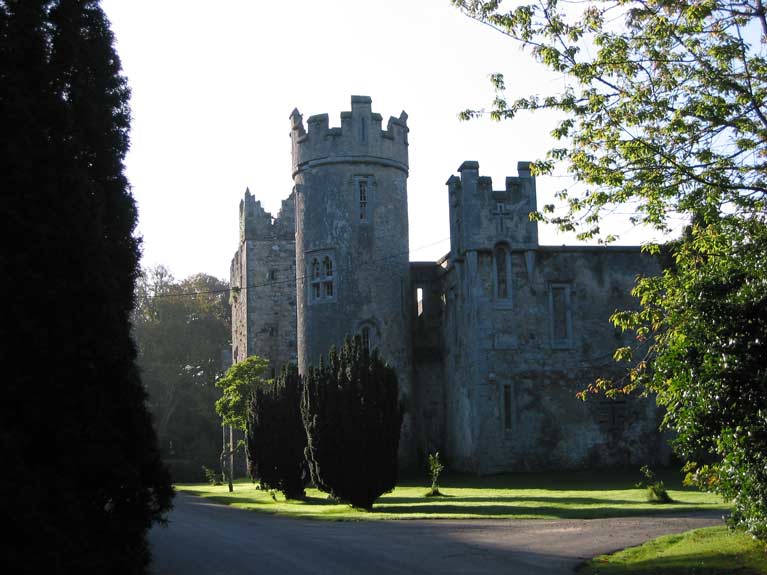
However, after Thomas Telford had completed his road from Dublin to Howth around 1823 to facilitate those using the ferry from there to North Wales and on to London (from where the road was mile-posted – with English miles too – all the way back to central Dublin), Raheny was tamed. So much so, in fact, that in recent years it has been judged one of the more quietly civilized, convenient and amenity-laden places in which to live in all Dublin.
Certainly, the Raheny and Clontarf area has, in St Anne’s Park, some of the most soothing and attractively laid-out woodlands in all Ireland. It is courtesy of the late Lord Ardilaun, whose fellow Irishmen were drinking his Guinness stout with such profitable enthusiasm that in the early years of the 20th century, he could somehow find the readies to create St Anne’s Park while at the same time splashing the cash big-time on Ashford Castle at the Mayo end of Lough Corrib in Connacht.
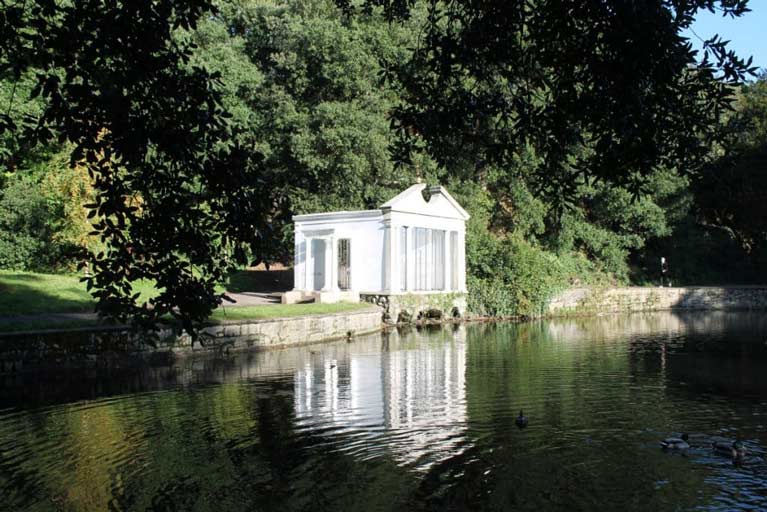 St Anne’s Park in Raheny is a peaceful and soothing place, a world away from the area’s former reputation as the haunt of highwaymen who made getting to Howth by land always challenge
St Anne’s Park in Raheny is a peaceful and soothing place, a world away from the area’s former reputation as the haunt of highwaymen who made getting to Howth by land always challenge
The result is that Raheny is now the haunt of discerning writers of distinction and others in the creative arts, whereas in Howth they’re a rough and ready lot who – even if they were the very essence of civilization as they headed towards the place – undergo some sort of Jekyll and Hyde transformation as they transit Sutton Cross.
As a result, the only conversation is about sailing and other sports, and when it’s about sailing it’s invariably soon focused on sailing success - on which they do place an almost indecent emphasis - or about the state of the harbour, which is badly in need of some serious dredging.
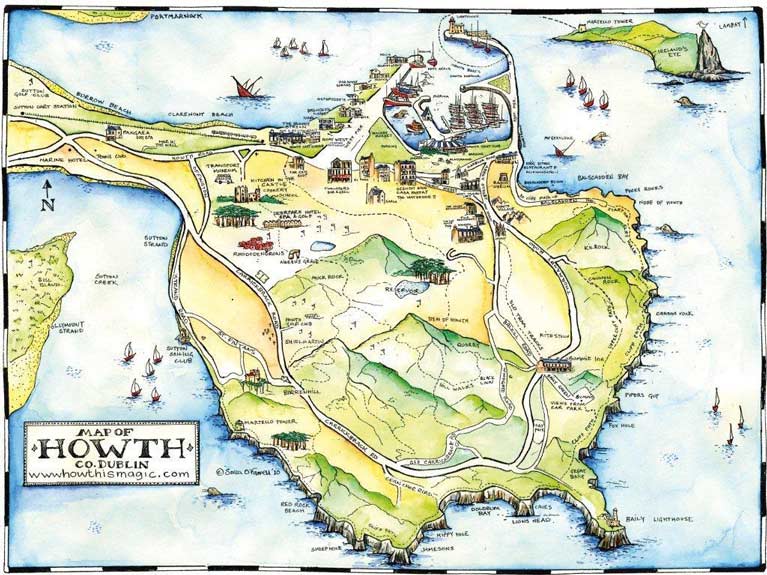 Howth as mapped for tourists. Locals walk the cliff clad in whatever they happen to be wearing, tourists arrive in full hiking gear…….
Howth as mapped for tourists. Locals walk the cliff clad in whatever they happen to be wearing, tourists arrive in full hiking gear…….
For sure, if you’re about Howth Harbour when the tide has even half risen, you’d think the place was well nigh perfect, with the 124-year-old yacht club in this increasingly good health, the sailing schools busier than ever, and the fishing fleet looking their best after the traditional August refit.
With its extraordinary selection of quayside restaurants in their quaint variety of buildings to every known design, and some unknown ones too, together with its scenic and harbour attractions, Howth is indeed - as somebody from Dun Laoghaire enviously claimed recently – a “tourism magnet”.
 Crazy but it works – this is early lunchtime on a Tuesday in September, and Howth’s extraordinary selection of restaurants on the West Pier is already busy, while fishing boats are berthed just a few metres away across the quay. Photo: W M Nixon
Crazy but it works – this is early lunchtime on a Tuesday in September, and Howth’s extraordinary selection of restaurants on the West Pier is already busy, while fishing boats are berthed just a few metres away across the quay. Photo: W M Nixon
Admittedly we who actually live in the place sometimes think that, thanks to some tomfool writers of cheapo travel guides, Howth can occasionally feel swamped by back-packing tightwads whose idea of a good day out is to take the DART to Howth, walk the incomparable cliff path, and then if they’ve any time left before heading back to their budget accommodation in the city, they can always go and look at people working around the fishing boats.
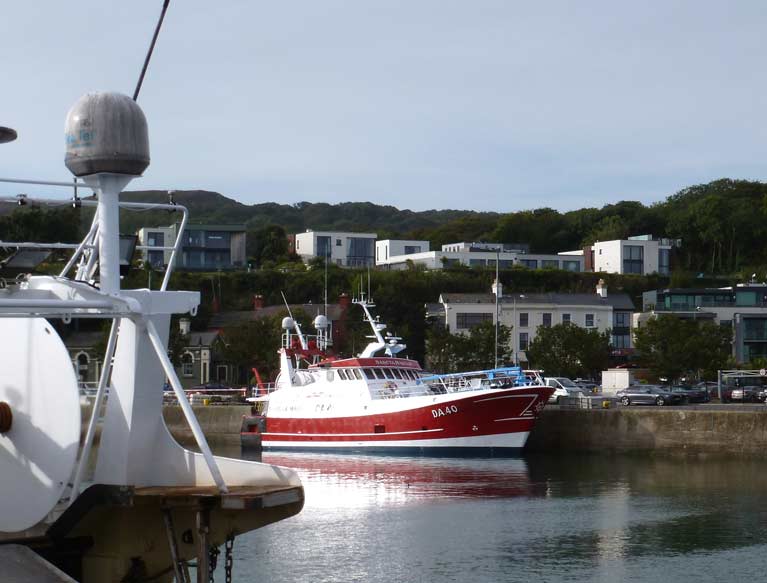 The Sancta Maria of Clogherhead in Howth for her annual refit. Being able to watch other people work makes the place even more of an attraction for tourists. Photo: W M Nixon
The Sancta Maria of Clogherhead in Howth for her annual refit. Being able to watch other people work makes the place even more of an attraction for tourists. Photo: W M Nixon
For really, there is no better way to add spice to your holiday than idly watching somebody else work, and the harder the better. Best of all is the happy recollection - as you trundle back to Hostelsville on the DART – that taking the cliff path and then watching the boat work underway doesn’t cost a cent…….
At the moment, it’s the picturesque combination of working and sailing harbour and exceptional coastal and hillside scenery with a cliff path all within easy reach of the city which seems to be the main selling point. Those of us who, back in the day, walked the cliff path in full evening wear at dawn after returning home from some May Ball or other in nearby Ireland, we do wonder a little about those determined-looking adventurers who currently disgorge from the DART in full hiking gear just to do the same….
But perhaps we should give thanks that the main thrust of the Howth package seems to be in the attractions of the here and now. We do have self-conscious re-enactments of the Asgard and Erskine Childers Howth gun-running of July 1914 now and again, but mercifully at the moment, there doesn’t seem to have been any significant tapping-in to Howth’s extraordinary literary links.
 Erskine & Molly Childers’ Asgard departing Howth at the conclusion of the successful gun-running at the end of July 1914, setting the trysail because the mainsail had been torn by over-enthusiastic help in its hoisting by the Volunteers. The Coastguard Station in the background was unfortunately demolished many years ago - unfortunate because today it would make a fascinating boutique hotel.
Erskine & Molly Childers’ Asgard departing Howth at the conclusion of the successful gun-running at the end of July 1914, setting the trysail because the mainsail had been torn by over-enthusiastic help in its hoisting by the Volunteers. The Coastguard Station in the background was unfortunately demolished many years ago - unfortunate because today it would make a fascinating boutique hotel.
Admittedly you do hear of Jonathan Swift’s links, and since then the poet Samuel Fergusson brought the place into focus, while of course Erskine Childers ingeniously wrote The Riddle of the Sands ten years before he reckoned that Howth was the perfect spot to drop a few guns ashore.
But dig a little deeper, and you’ll find that the family of William Butler Yeats lived for two years in the early 1880s in a tall damp and cold house (of which his sisters constantly complained) on the Howth waterfront, a house which Mick Hunt has since brilliantly transformed into a bright and warm and cheerful home. Then too, not only does a central scenes from Joyce’s Ulysses feature Howth, but as well one of the great Howth characters, Judge Boyd whose son Herbert designed the ever-young Howth 17s in 1897, was named-checked in Ulysses as the originator of the old Dublin saying: “It wouldn’t break Boyd’s heart”. But as for the precise origin of that, well, you’ll just have to finally finish reading Ulysses with real concentration to find out where it applies.
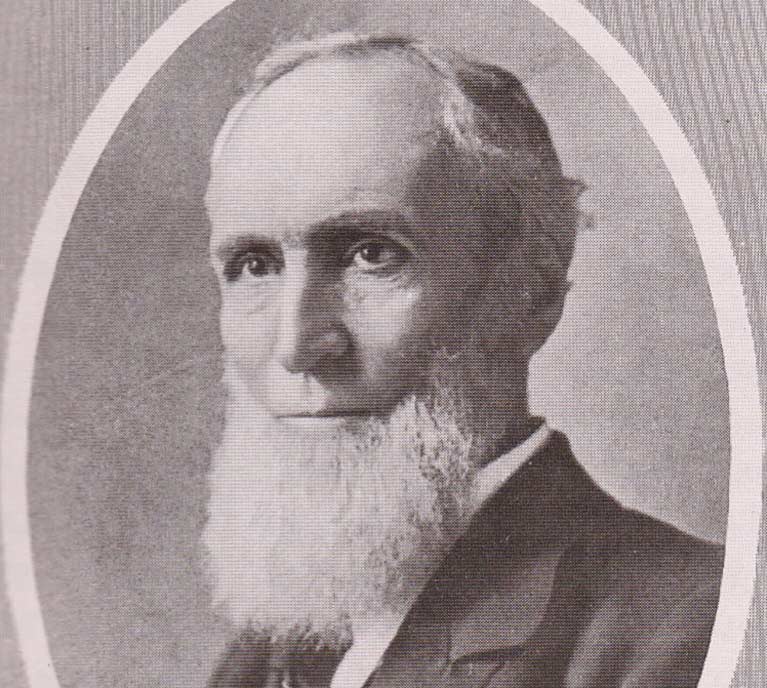 A pioneer of sailing from Howth, Judge Boyd was such a noted Dublin character that he was name-checked in Joyce’s Ulysses
A pioneer of sailing from Howth, Judge Boyd was such a noted Dublin character that he was name-checked in Joyce’s Ulysses
At a more modern level, J P Donleavy’s classic The Ginger Man has its hero living for a while in a clifftop house at Balscadden in Howth, a house under which storms crashed in caves with a hollow roar. One morning, in dire financial straits in this house, the Ginger Man cut a pale pink blanket into scarf-like strips, adorned himself with one of those strips in order to pass muster as a Trinity Pink and strode with totally artificial confidence and his best efforts at a West Brit accent into Findlaters, the up-market grocery store beside Howth Harbour, where he conned his way into opening an account in order to fill the larder back up on the cliff.
 Findlaters of Howth – connected both to The Ginger Man and the Race Programme of Howth Sailing Club
Findlaters of Howth – connected both to The Ginger Man and the Race Programme of Howth Sailing Club
These days, Findlaters is the noted pub with restaurants which is the flagship of the Wright hospitality conglomerate, and the Wright brothers Michael and Darren are into the sailing with various international ventures (again more anon), while at home they campaign the classic Half Tonner Mata, which took the Irish National Title in the Half Ton Championship at Kinsale at the end of June, while Darren’s son Rocco is, of course, a young star in the Optimist class at international level, having taken tenth at the Worlds in Antigua in July, and cutting a swathe to the podium in the Optimist scene in Europe.
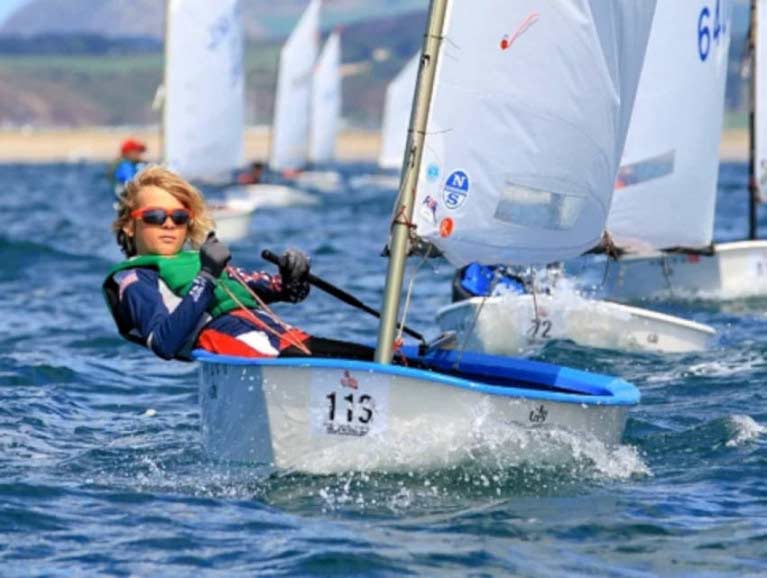 Rocco Wright - his tenth overall at the Optimist Worlds in Antigua in July was the highest placing ever obtained by an Irish helm
Rocco Wright - his tenth overall at the Optimist Worlds in Antigua in July was the highest placing ever obtained by an Irish helm
But for old Howth fans, the truly wonderful sailing connection to Findlater’s is that when the new Howth 17 Class set its sailing rules for its first season in 1898, it stated: “The time to be taken from Findlater’s Clock”. In pre-1916 Ireland, time was a very local affair, and the conspicuous but now long-gone clock on the front of Findlater’s was a blessing for the race officers of the recently-formed Howth Sailing Club and its new class.
So with untapped historical and literary connections, maybe at the moment, we’re only looking at a trickle of small-spending Howth visitors compared to what the place might attract. Imagine being like Venice and Dubrovnik, trying to find polite ways of keeping them out…..
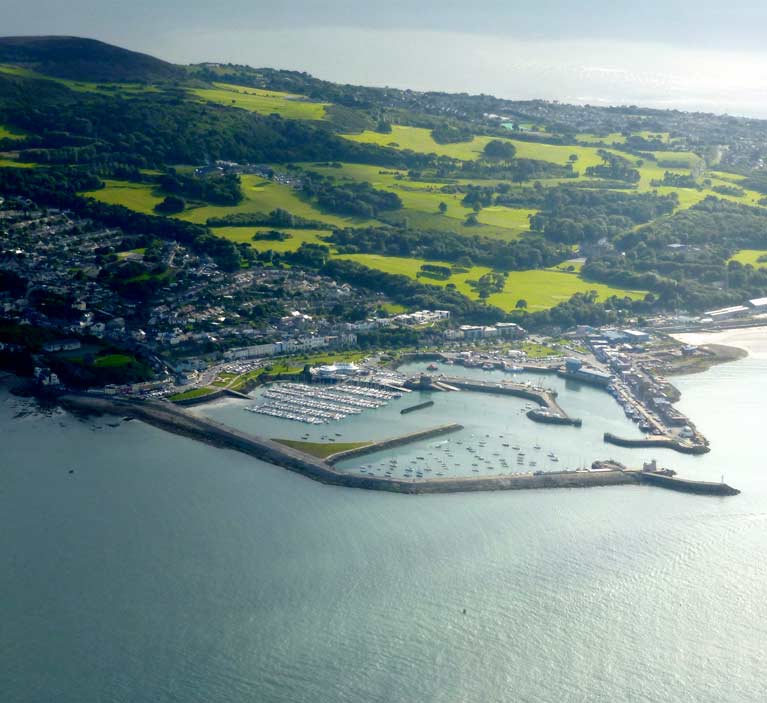 Ripe for development? Howth Harbour with the golf courses and castle (lower right) beyond. It is expected that the new Tetrarch hotel will be built up the hill on the site of the moth-balled Deerpark Hotel (middle left). Photo: W M Nixon
Ripe for development? Howth Harbour with the golf courses and castle (lower right) beyond. It is expected that the new Tetrarch hotel will be built up the hill on the site of the moth-balled Deerpark Hotel (middle left). Photo: W M Nixon
That said, it has to be admitted that many visitors to Howth are ready and willing to spend, and with the St Lawrence family now exiting Howth Castle after a brief occupation of 842 years, who knows but what a new high-end hotel created by the Tetrarch think-tank in the castle grounds will provide to make the best of the incomparable outlook from the hill. Certainly there will be those who will be able to take the long view, for after all we still have four families in Howth of centuries-old Danish descent – the Harfords, the Ricards, the Thunders and the Waldrons – who were here before the St Lawrences arrived.
In those weighty tomes, the Saga of the Harfords, the Road of the Ricards, the Trail of the Thunders, and the Way of the Waldrons, the advent of the St Lawrences in Howth will be seen as no more than a passing incursion, maybe worth no more than a chapter or two. But before the occupants of the castle take their departure, let it be said that it isn’t really true to claim that the St Lawrences were of an old Norman family. They took the name St Lawrence because they captured Howth on St Lawrence’s Day, August 10th 1177, in a private-venture offshoot from the Norman invasion of Dublin. They did it in the Battle of Evora, aka the Battle of the Bloody Stream, right beside where the pub of the same name – which is also the DART station, but that’s Howth for you – now stands.
 The difference between their railway stations speaks volumes about the difference between Dun Laoghaire and Howth. While Dun Laoghaire Station is a very formal building designed by John Skipton Mulvaney and now used as a fine dining restaurant, Howth Station (above) exudes good cheer from a standard Great Northern Railway design, and it is also a pub and eaterie known as The Bloody Stream in commemoration of the effects of the Battle of Evora nearby in 1177. Photo: W M Nixon
The difference between their railway stations speaks volumes about the difference between Dun Laoghaire and Howth. While Dun Laoghaire Station is a very formal building designed by John Skipton Mulvaney and now used as a fine dining restaurant, Howth Station (above) exudes good cheer from a standard Great Northern Railway design, and it is also a pub and eaterie known as The Bloody Stream in commemoration of the effects of the Battle of Evora nearby in 1177. Photo: W M Nixon
The main man in this in this pivotal little skirmish was one Tristram Armoricus from Armorica, the Place-by-the-Sea, as the long-gone Romans had called Brittany. He was a war-and-plunder machine with a horse, sword, and lance for hire, whose best reward was likely to be any place he could capture, a fighting man who had pledged his loyalty to the Norman invasion in Rennes Cathedral in Brittany, and had joined the preparing Norman invasion forces of Strongbow and his chums in southwest Wales direct from Brittany. Thus the first St Lawrence was Breton, and probably had much more Celtic blood than those of Danish extraction whom he vanquished in Howth.
But that’s really neither here nor there in modern Howth, which has people from everywhere. Some of them admittedly have the slightly bewildered look of people who, having found their way across the narrow gap which gives access to the place and ensures its peninsular status, have been unable to find their way out again.
Others have learned that at certain times, the best way to reach Howth or leave it is in the old pre-Telford style, by boat. But they too may have a slightly bewildered look from time to time, for they may be wondering why - as Howth’s harbour users have fulfilled their side of the deal with the official authorities by making the best possible use of the harbour - why haven’t the authorities shaped up to their part of the bargain by giving the place a much-needed dredging?
 Howth Harbour at low water. When this photo was taken in 2012, it was at a time of drought, and harbourside green spaces and trees were suffering. The silting was already a problem, but less so than it is now.
Howth Harbour at low water. When this photo was taken in 2012, it was at a time of drought, and harbourside green spaces and trees were suffering. The silting was already a problem, but less so than it is now.
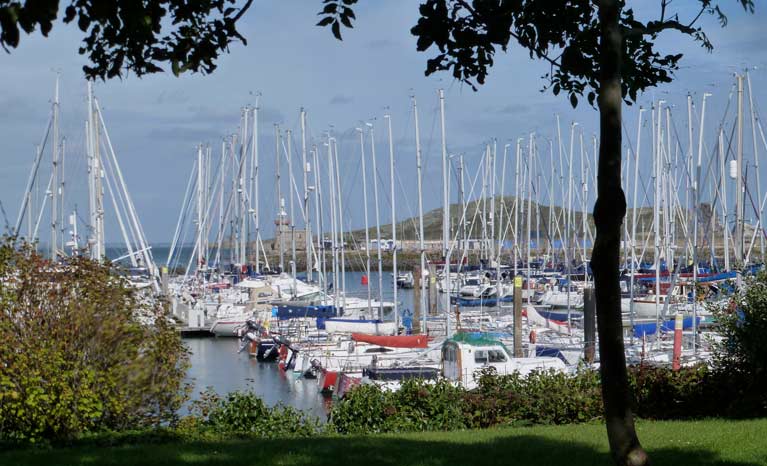 Howth Marina as it is today. One of the “happy accidents” in the creation of the modern harbour is the amount of waterside greenery, shrubbery, and grassy spaces. This is in marked contrast with Dun Laoghaire, where the only accessible green space close beside the harbour is the area of grass between the Royal Irish YC and the Irish Lights complex. Photo: W M Nixon
Howth Marina as it is today. One of the “happy accidents” in the creation of the modern harbour is the amount of waterside greenery, shrubbery, and grassy spaces. This is in marked contrast with Dun Laoghaire, where the only accessible green space close beside the harbour is the area of grass between the Royal Irish YC and the Irish Lights complex. Photo: W M Nixon
It was 1982 when the basic harbour shape as we now know it was virtually completed after several years of massive work and some very total disruption of village life. Yet in the 37 years since, there has only been some minor dredging, such as removing a rock in the marina entrance which had somehow been overlooked, but which was soon discovered in bone-shaking style as yachts became bigger and slightly deeper.
So that’s 37 years lacking in the most basic routine maintenance needed for a harbour which, as it is set in a sandy coastal area and has strong tides pouring past its entrance, has always been liable so silting. So much so, in fact, that in times long past the fairly frequent visits of the Government bucket dredger Sisyphus (they’d a way with words in those days) was taken for granted.
Except for the increasingly urgent matter of depth reduction, Howth is an excellent harbour. Maybe that’s the problem. Above the surface, to the casual observer, it all looks world class, and under Harbour Master Harry McLoughlin is certainly tidier than it has ever been. But below that gleaming water surface, all is not as it should be.
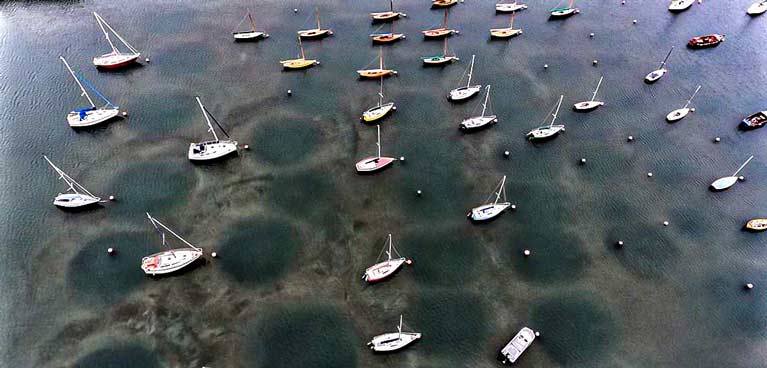 Ploughing their lonely circle……..in Howth’s outer harbour with its swinging moorings, the depth has reduced so much that even the Howth 17s – which draw only 3ft 7ins – are ploughing their own lonely circle in the soft mud at low water. Photo: Stormyphotos/Tom Ryan
Ploughing their lonely circle……..in Howth’s outer harbour with its swinging moorings, the depth has reduced so much that even the Howth 17s – which draw only 3ft 7ins – are ploughing their own lonely circle in the soft mud at low water. Photo: Stormyphotos/Tom Ryan
It wouldn’t be allowed to happen in any serious maritime country.
But as we’ve pointed out before, we may be an island nation, but we’re not really a maritime-minded country. In fact, the most successful maritime country is The Netherlands, which shouldn’t really be a maritime country at all. But the Dutch are determined when they set their minds to it, and in The Netherlands, all their many harbours are routinely dredged at least every five years, and more frequently if special local conditions make it necessary.
This might seem like home-town griping from a local, but the fact is that Howth, as it is today, is as a result of several agreements reached between Government departments – some of which have since been subsumed into other departments and may not be too aware of all their responsibilities - and the harbour users of Howth.
Put at its most basic, the Government agreed to improve the harbour to such an extent that, in effect, they provided an empty new harbour with great potential, while the users – fishermen and recreational sailors alike – agreed to invest privately in order to make the new harbour work.
Thus the fishing fleet which regularly uses Howth – not all of which necessarily regard Howth as their home port – are active in keeping the place busy as a fishing port and paying substantial dues, while also using the employment-providing revenue-generating ship repair and maintenance facilities which the government had installed.
As for the sailing community, they made an even bigger leap in the dark. In order to draw clear boundaries between commercial and leisure use, the government agreed to provide a newly-dredged basin in the eastern part of the harbour on condition that Howth Yacht Club install a marina in it at HYC’s own expense, and also build a completely new clubhouse beside it (also at their own expense) in order to move all recreational boating activity away from the new fish dock in the western portion of the harbour.
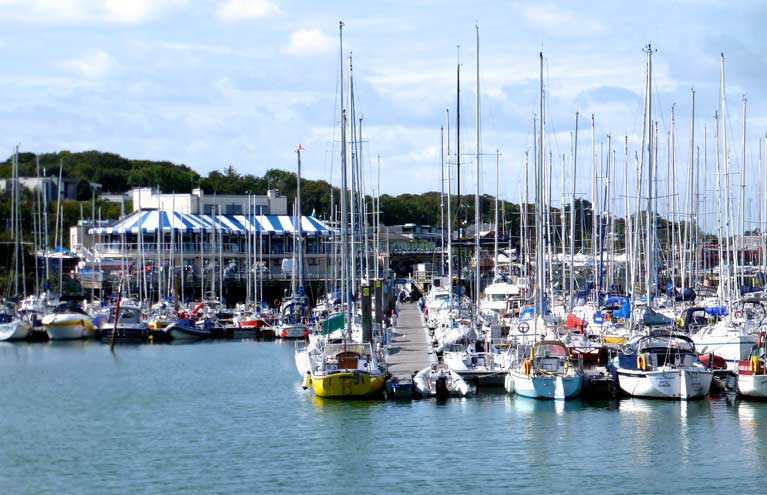 Back in the 1980s, the new Reg Chandler-designed Howth Yacht Club (winner of an RIAI medal) was designed to be part of an integral part of a complex with the marina, with the main marina walkway designed to lead directly to the principal seaward entrance to the club building. Photo: W M Nixon
Back in the 1980s, the new Reg Chandler-designed Howth Yacht Club (winner of an RIAI medal) was designed to be part of an integral part of a complex with the marina, with the main marina walkway designed to lead directly to the principal seaward entrance to the club building. Photo: W M Nixon
For those of an optimistic outlook in the sailing community, it seemed a proposal of hopeful potential. But for pessimists – just under half as the serious debates got under way – it seemed a huge leap into unknown and disaster-fraught territory, and they sought some much more modest proposal.
In the end, the vote - in a packed-out and passionate town hall sort of meeting - was in favour of the big vision. But the work was only beginning, as it has been kept going ever since, for running a yacht club in the middle of a harbour which becomes a tourism venue thanks in part to the club’s success means that in some ways the club is its own undoing. This is because the hospitality facilities which it has installed as part of the package are soon being rivalled by nimble private operators – the precursors of today’s pop-up restaurants – who could see ready new opportunities in people seeking the ocassional change of venue for eating out, and there were many of them – members and non-members alike - thanks to the new perception of Howth as a gastronomic centre, a perception which the club had done so much to create.
So as we move forwards towards 2020 - when Howth Yacht Club will be celebrating its 125th Anniversary with a very full programme while maintaining due deference to the Royal Cork’s Tricentenary – the wish-list by all in Howth at every level of interaction with the harbour is becoming clearer by the day.
High on that list would be a hope that the authorities will realise that, 32 years after it opened its new award-winning clubhouse in 1987, Howth YC is operating in a very different world. People’s behavior and their way of life generally has changed in ways large and small.
The big clubhouse is trying to function in a socio-economic environment very different from that of 1987. The business model which made the club such an economic success in its first 20 and more years no longer fits so well into changing circumstances, even if very skilled and cost-conscious management has brought some current improvement to the situation. Clearly, what the club needs is some new thinking on the part of the authorities in order to let them optimize their clubhouse’s potential without in any way diminishing its key role in the community.
 Two symbols together. The Howth 17s have come to symbolize Howth sailing, while the Fastnet Rock has become the symbol of maritime Ireland and international offshore racing. In 2003 they came together during Glandore Classics Regatta which was attended by 15 Howth 17s, when several of them – including Roddy Cooper’s Leila seen here – sailed round the Fastnet Rock. It gives some idea of the Howth Seventeens’ antiquity when it is remembered that Leila had already been sailing for five seasons when the Fastnet Rock lighthouse became operational in 1904. Photo: W M Nixon
Two symbols together. The Howth 17s have come to symbolize Howth sailing, while the Fastnet Rock has become the symbol of maritime Ireland and international offshore racing. In 2003 they came together during Glandore Classics Regatta which was attended by 15 Howth 17s, when several of them – including Roddy Cooper’s Leila seen here – sailed round the Fastnet Rock. It gives some idea of the Howth Seventeens’ antiquity when it is remembered that Leila had already been sailing for five seasons when the Fastnet Rock lighthouse became operational in 1904. Photo: W M Nixon
But right now, top of the list and with a certain urgency is the lack of depth in parts of the harbour. The requirement for dredging has of course been under discussion for a long time, and an increasingly clear programme has emerged, while a much more cohesive approach has also developed. Although the needs of the fishing fleet are obviously paramount, the fishermen’s leaders – Sean Doran and John Lynch – are in the forefront of seeing the harbour in its entirety, and when they brought Taoiseach Leo Varadkar out to see Howth and its problems for himself back in December, it was their suggestion that his tour of the harbour should conclude with cups of teas for all in the HYC clubhouse, the day rounded out by the Taoiseach meeting leading sailors and junior trainees from the club and the five neighbourhood schools which use the club’s sailing training programme.
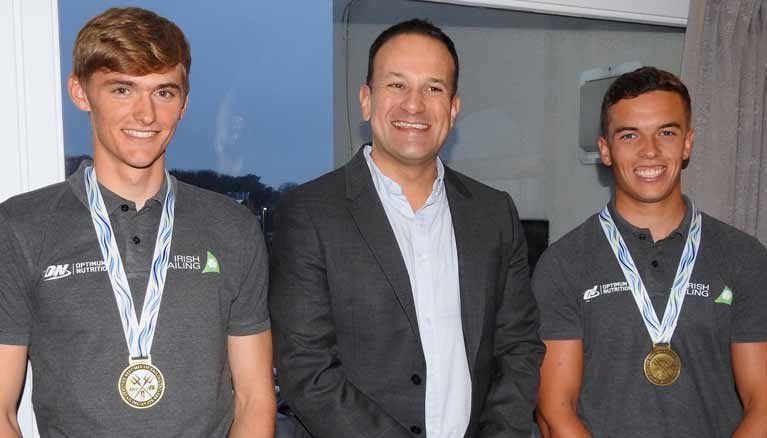 International 49er Medallists Rob Dickson (left) and Sean Waddilove (right) with Taiseach Leo Varadkar in HYC during his visit to Howth last December.
International 49er Medallists Rob Dickson (left) and Sean Waddilove (right) with Taiseach Leo Varadkar in HYC during his visit to Howth last December.
Despite the inevitable limitations placed by the increasing siltation situation, ad hoc solutions have been found around them to keep the programme moving along, and the club’s top success in running a record-turnout 11-nations Irish Optimist Nationals in August in very demanding conditions was of course not particularly depth reliant, but it certainly tested the strength and flexibility of Howh’s capacity to handle major events.
Thus ways will be found of continuing while the dredging is under way, and at the moment the best scenario timescale is that work on improving and deepening the Middle Pier’s west side for use by the fishing fleet will begin in 2020, but the major harbour dredging programme won’t start until 2021, and will last for at least 18 months.
So that’s two-and-a-half years of harbour disruption of various levels in prospect from next year (unless, of course, a messy Brexit upsets all Government finances). But for those of us who lived in the village during the massive harbour work which went on for years in the early 1980s (when the Irish economy was actually shrinking), we know that relatively speaking, this is a much smaller disruption coming down the line. Its ultimate benefit will be appreciated by all, and that cussed Howth ingenuity will find ways of keeping the harbour and its fishing and sailing functioning in one way and another.
 Commodore Ian Byrne with HYC’s Luke Turvey, one of Ireland’s leading Optimist racers who placed second overall at the 11-nation Irish Optimist Open Nationals at Howth in August. Photo Sara Lacey
Commodore Ian Byrne with HYC’s Luke Turvey, one of Ireland’s leading Optimist racers who placed second overall at the 11-nation Irish Optimist Open Nationals at Howth in August. Photo Sara Lacey
Meanwhile, a quick canter through some Howth sailing achievements to date in 2019 show the kind of pace that is being set. Laura Dillon won the UK Open National Women’s Championship, Jonny Swan’s classic Half Tonner Harmony won Class 3 in the Scottish Championship, the Wright brothers (they should call their boat Kittyhawk) won the Irish Half Ton Nationals at Kinsale with Mata, young Rocco Wright then went on to get tenth in the Optimist worlds, apparently the highest-ever by an Irish helm, Eve McMahon won the Gold in the U17 Laser Radial Worlds in Canada, Robert Dickson & Sean Waddilove won the Bronze in the U23 49er Worlds, Jamie McMahon won Gold in the U21 Laser Radial Euros, Aoife Hopkins qualified for the final play-off for the 2020 Olympic spot in the Women’s Laser Radials, Alistair Kissane won the Moth Nationals, the Howth-inspired all-Ireland J/24 Headcase with HYC’s Cillian Dickson and Sam O’Byrne on board won the J/24 Nationals on Lough Erne, the Gore-Grimes family with the X302 Dux won Class 3 at the ICRA Nats, the Sigma 33 Invader (Stephen & Des Mullaney) was top Irish boat in the extra-large Sigma 33 40th Anniversary fleet in the Volvo Dun Laoghaire Regatta, the veteran Club Shamrock Demelza (Steph Ennis & Windsor Lauden) won her non-spinnaker class at the VDLR 2019, Dave Quinn of HYC is the 2019 Irish Laser Masters Champion, Pat Kelly’s J/109 Storm (whose club affiliation Howth is happy to share with Rush SC) is the new 2019 RC35 Champion, and in that incredible Irish Optimist Nats, while James Dwyer Matthews of Kinsale was overall winner, Howth were very strongly represented in the top ten with Luke Turvey second, and the season-long rankings have Matthews (Kinsale) first, but with Rocco Wright (Howth) second and Luke Turvey third.
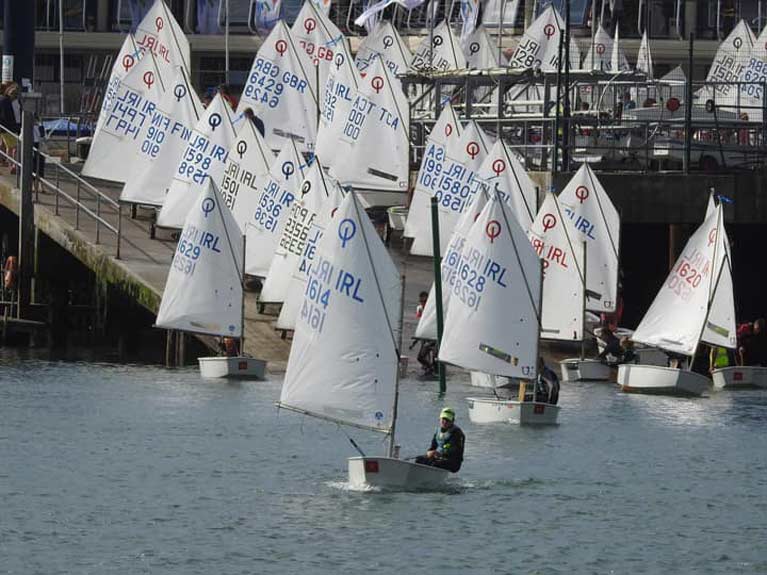 This is what 185 Optimist dinghies starting to stream seaward in a well-choreographed launching operation looks like – Optimist Nationals at Howth, August 2019
This is what 185 Optimist dinghies starting to stream seaward in a well-choreographed launching operation looks like – Optimist Nationals at Howth, August 2019
As for the local classes which are the backbone of Howth sailing, the Howth 17s had a reasonable across-the-fleet spread, though it has to be admitted that when it really mattered – and particularly in the Annual Championship –Deliginis (Massey family & Mikey Twomey) were firmly in front, while in the Puppeteer 22s, Trick or Treat (Alan Pearson & Alan Blay) were on tops generally, but Yellow Peril (Neil Murphy & Conor Costello) shone in the Annual Championship.
Looking to the future before 2019 ends, doubtless by the time it happens we’ll find that there are Howth contenders in the Middle Sea Race at the end of October, and meanwhile it has been confirmed that the Wright brothers crew, with Kieran Jameson pulling things together, have chartered a First 40 for the Rolex Sydney-Hobart Race 2019 on December 26th, a follow-up campaign to their highly-regarded third in class with the Lombard 45 Pata Negra in last year’s RORC Caribbean 600.
The largest section in the club, Howth YC’s very large Cruising Group, as ever will take a proper amount of time to assess where they’ve been and how, but they certainly do get out and about on coasts near and far. As for cruising visitors to Howth Marina, their numbers are up despite the occasional access problem, and interestingly enough they’re staying for longer, for as one of them put it: “We can be in Dublin city centre in 23 minutes by DART if we fell like it, the airport is very handy, and above all that, Howth is a very entertaining and hospitable place to be”.
So today this “entertaining and hospitable place” faces up with enthusiasm to the staging of its 38th Annual Autumn league, all made possible by the presence of the all-year security of the Marina. And it’s so very much part of the Howth story that it is being partnered by Beshoff Motors, the noted sourcers and importers of specialist cars, for the Beshoffs are very typical representatives of contemporary Howth
Most folk will be aware that Beshoff is a name which occurs fairly frequently on business facades in north Dubin and out east in Howth, yet by no stretch of the imagine is it Old Irish in any sense.
It was one Ivan Beshoff who brought the name here. He was a surviving mutineer from the crew uprising on the Tsarist Russian battleship Potemkin at Odessa in the Crimea in 1905. Having taken over the ship, the crew took her across the Black Sea to seek political asylum at Constantia in Romania, and there young Ivan Beshoff decided it as time to strike out on his own before the sclerotic Imperial Russian system came sufficiently to life to reclaim the ship.
 Smokin’ along….the battleship Potemkin - not quite a flagship for Howth, perhaps, but there are certain connections
Smokin’ along….the battleship Potemkin - not quite a flagship for Howth, perhaps, but there are certain connections
So he took off and walked west across Europe. Right across an entire continent. Then he came to the English Channel and got himself across that and walked across England and Wales until he got to the sea again at St George’s Channel and the Irish Sea. And there he managed to get aboard ship and got to Ireland where he decided he’d done enough walking. He settled in Clontarf in north Dublin and got married and became a house painter and lived well and happily until the age of 105, continuing to enjoy life such that he was still getting dressed up in style and going ballroom dancing every Saturday night past his hundredth birthday, and begetting a mighty clan who are now much more Irish than the Irish themselves.
All that explains why, when you head down the pier at Howth in search of sustenance, the first of many restaurants on your left is called Ivan’s. And it also explains why, if you feel a sudden urge to own a Bugatti or some such exotic or simply rather good car, if you don’t want to do all the internet searching and form filling and hassle that’s involved by doing it personally, then the man to go to is Jeremy Beshoff.
Thus Beshoff Motors supporting the Howth YC Autumn League is so very Howth. And I’m much happier to promote Howth’s links to Ivan Beshoff than I am to talk of our fairly tenous but still definite links to the not-very-likeable William Butler Yeats. In fact, it’s much more agreeable to reflect on the connection to the charismatic Ginger Man than to find links to the cold fish Yeats, and we can also find a link to the congenial Oscar Wilde if we’ve a mind for it. That’s how it is in Howth as we contemplate the start of the 38th Autumn League, and reflect on the impending realities of the very necessary dredging of a popular and busy harbour which is so much an integral part of our village.
Optimism prevails. Problems are seen as opportunities. Nevertheless, at the moment we’re quietly hoping that something doesn’t come up which proves to be an insoluble opportunity…
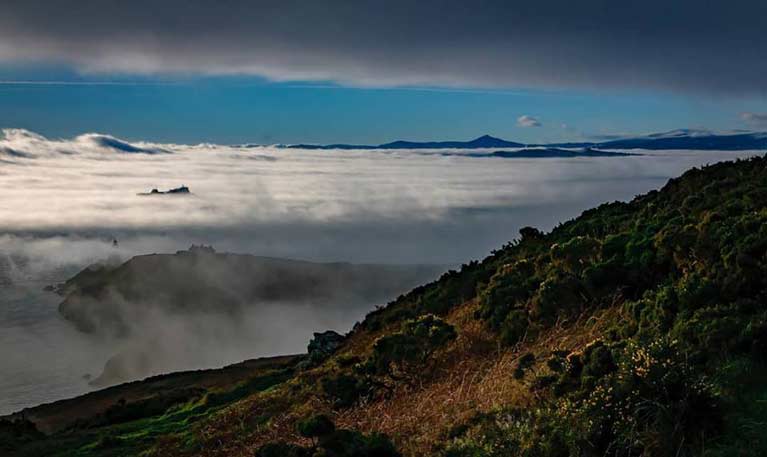 The rest of the world as seen from Howth. The view southward from the Hill of Howth early on a misty morning, with Killiney Hill and the Wicklow Hills in the distance and the bridge of the P&O Ferry Norbay just visible above the fog as she heads into Dublin Bay, bound for Dublin Port. Photo: Stormyphotos/Tom Ryan
The rest of the world as seen from Howth. The view southward from the Hill of Howth early on a misty morning, with Killiney Hill and the Wicklow Hills in the distance and the bridge of the P&O Ferry Norbay just visible above the fog as she heads into Dublin Bay, bound for Dublin Port. Photo: Stormyphotos/Tom Ryan
Make Sailing Simple Again – Some Committee Boat Starts Can Work Against Racing Enjoyment
Our header photo this week may not be the greatest in terms of clarity and technical brilliance, let alone jaw-dropping drama writes W M Nixon. But it tells us much about our peculiar sport of racing under sail, that two genuine and experienced sailing enthusiasts could examine this photo in detail and argue for hours about whether it is a Good Thing, or a Travesty of Sporting Justice.
It shows the Dublin Bay 25 class making a start through the mouth of Dun Laoghaire Harbour, which would have been Kingstown when the image was taken, as it’s probably pre-1914. But even were it in the 1920s or ’30s, many of the locals – including, one would think, practically everyone on these yachts - continued to call it Kingstown even though it had officially reverted to Dun Laoghaire in 1920, meaning that it had been Kingstown for just 99 years.
Be that as it may, it shows a classic summer’s day - probably a Saturday afternoon, though they had racing on some weekday afternoons too in the GODs (the Good Old Days) – and an easterly sea breeze is making as the 25ft LWL class, the aristocrats of the Dublin Bay One Design scene and the J/109s of their time, get their race under way.
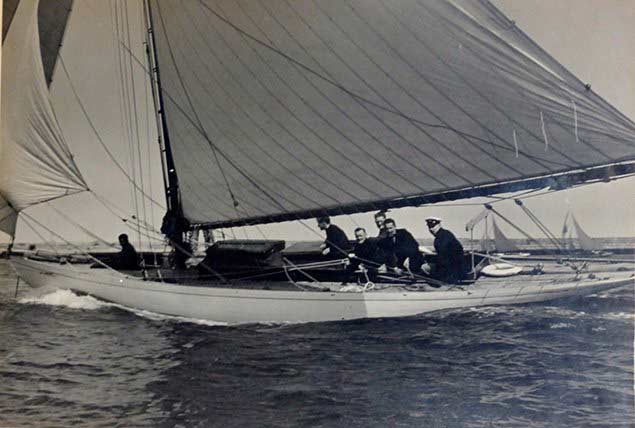 The J/109s of their day – the Purcell brothers’ DB 25 Acushla racing on Dublin Bay in 1938. An early owner was the legendary international tenor John McCormack, and Macushla was one of his most popular songs
The J/109s of their day – the Purcell brothers’ DB 25 Acushla racing on Dublin Bay in 1938. An early owner was the legendary international tenor John McCormack, and Macushla was one of his most popular songs
It may well be that their actual start was made in-harbour from a mark boat off the waterfront for the convenient viewing of the many members and their guests in the distinguished clubhouses (who would have observed proceedings for about four minutes as it was otherwise interrupting their lunch, but never mind). Thus it might be said that in accessing Dublin Bay through the harbour mouth, they were getting two starting lines for the price of one.
But either way, the last thing on anyone’s mind was the thought that people should go to much trouble – or indeed any trouble whatever – to provide a starting line which was at exactly 90 degrees to the basic wind direction. On the contrary, the thinking at virtually all sailing centres was that you should get the boats away as quickly and conveniently as possible from a start line near their moorings, and finish them in similar style. For in those pre-auxiliary-engine days, finishing at some distance from home with the wind failing was a big turn-off in every sense of the term, and it was certainly bad for club racing’s popularity.
Anyway, that header photo, which is such a long up the page by now that we’ll show it again, would seem to suggest that the boat on the left – no 2, Punctilio which was the last DB25 to leave Dun Laoghaire, she was here until the 1970s – is well set up, as they’re probably racing towards a first mark in mid-bay. She’s nicely on a closer-than-close reach but not actually hard on the wind, she’s just hitting the edge of the seaward-going ebb which will sharpen the breeze and enable her to sail at the optimum angle, and she looks to have freed herself from getting any dirt from the group close under the east pier.
 Here’s that start again for further examination
Here’s that start again for further examination
But don’t dismiss them entirely. The boat right under the lighthouse may be carrying her way with limp sails through a small calm spot. But within seconds she will be getting a benefit from the mini tide rip which swirls round the pier end, and suddenly her overall position could be transformed.
For in the GODs, the boat which has had the best start was the boat which was best placed after about a mile of racing. And who knows, but it might even be the boat in the foreground, No 1 which could either be Whisper built in 1898 by local shipwright J E Doyle, or it could be Fodhla built in 1903 also by J E Doyle.
For Fodhla was built for the Viceroy, the Earl of Dudley and the nascent 25ft class were so chuffed that Himself up in The Park was getting one of the boats (it was a surprise present from his wife) that they decided Fodhla should also be No 1. Only in Dublin Bay would they have two No 1s, while they never ever had a No 13.
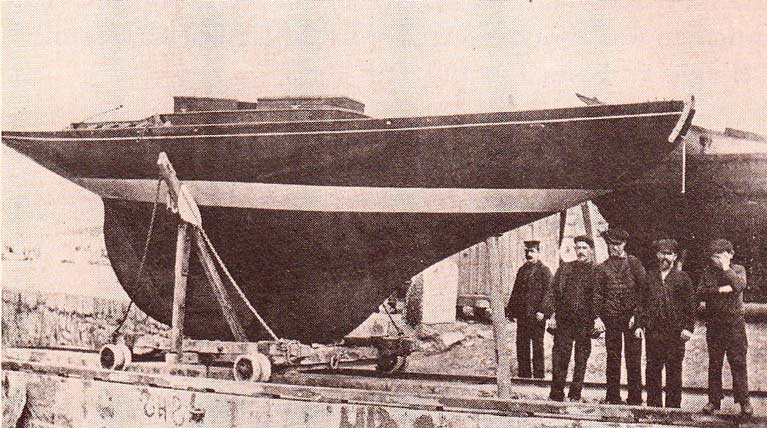 The new Fodhla ready for launching by builder J E Doyle into the Coal Harbour in what was then Kingstown in 1903. As the owner-to-be was the Viceroy, the class association caused eternal confusion by making her No 1 when they already had a No 1, built in 1898. Photo courtesy DBSC.
The new Fodhla ready for launching by builder J E Doyle into the Coal Harbour in what was then Kingstown in 1903. As the owner-to-be was the Viceroy, the class association caused eternal confusion by making her No 1 when they already had a No 1, built in 1898. Photo courtesy DBSC.
Anyway, Fodhla or Whisper or whatever is going like a train as she carries a private puff of breeze from within the harbour, but you’ll notice that her racing flag atop the jackyard tops’l suggests she is reaching, yet they already have her trimmed for the wind being well ahead of the beam, in anticipation of the significantly different direction outside.
Or it could be we’re flattering No 1’s crew? Maybe they’ve been surprised by this sudden puff from abeam or even slightly aft of it. But as it’s only going to last for a few seconds until they get into the basic breeze in the bay, it’s hardly worth their while adjusting the four different sheets which the complex rig of the DB25 requires, and it’s only going to cause confusion with the sister’s son, young Willie, who is trying to make himself comfortable in the sunshine on the lee deck, and fell overboard last time out, costing them a couple of places……
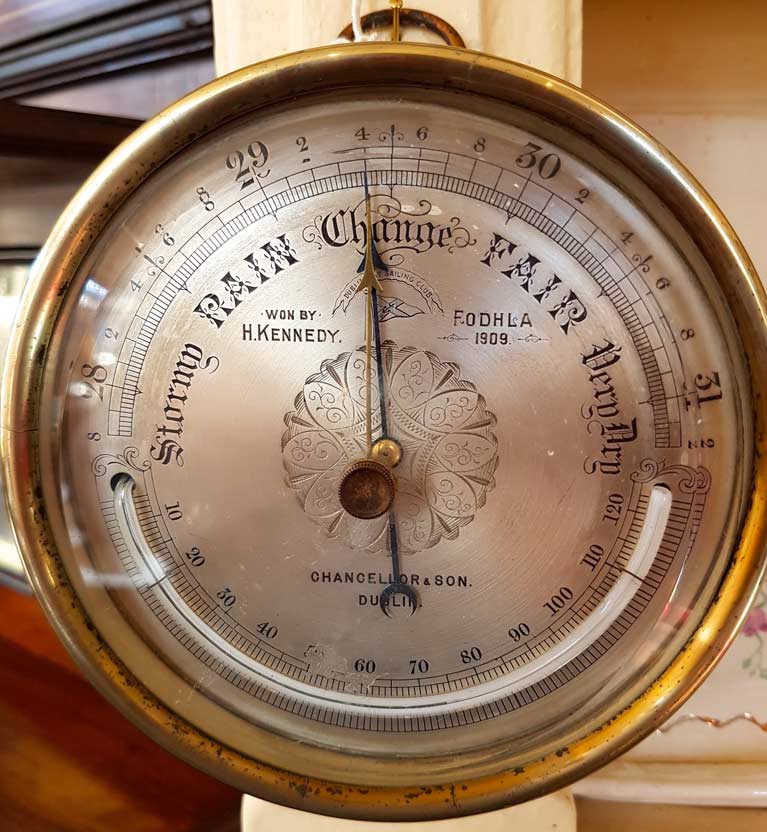 Fodhla was only briefly in the ownership of the Viceroy – by 1909 she was winning races for one H Kennedy, as this DBSC prize barometer from Vandeleur Antiques of Kilrush reveals.
Fodhla was only briefly in the ownership of the Viceroy – by 1909 she was winning races for one H Kennedy, as this DBSC prize barometer from Vandeleur Antiques of Kilrush reveals.
Be that as it may, we’re assuming one of our experienced observers is a sailor who enjoys racing which is as much an interaction with coastal features and local quirks of sea and weather as it is with the straightforward achieving of boat speed in clear relatively tide-free water, and he or she sees this start as a delightful challenge.
But equally we assume the other is a purist whose highest ideal is Olympic sailing in waters as interference-free as possible, with courses of a very set type with a starting line virtually at 90 degrees to the wind, which must be of minimal strength and steady direction, racing round marks well clear of any land influence with minimal and preferably no tide, and putting the emphasis on windward-leeward courses in which the crews are always busy busy busy. He or she, therefore, sees this start as a lazy luck-reliant shambles.
 The beau ideal of a modern start, far at sea and dead to windward, with an extra mark boat at mid-line set back a very few feet to keep the sighted line in order
The beau ideal of a modern start, far at sea and dead to windward, with an extra mark boat at mid-line set back a very few feet to keep the sighted line in order
Inevitably, in an era when public awareness of sailing just about extends to Olympic medals and no further, the Olympic disease is spreading down to every level of our sport. Characterful starting huts on the end of piers or on picturesque shoreside seapoints, both with eminently sensible transit markers setting the line, are discarded in favour of Committee Boats, mark-laying RIBs, and a general support cast of dozens of pious folk including, God help us, umpires…...
"the Olympic disease is spreading down to every level of our sport"
Even back in the 1990s, it was sometimes at the stage where there seemed to be more people on the management side than were actually racing the boats. But the 1990s being the final years of that prelapsarian era before 24/7 electronic communication meant that you now never knew when you actually have time off, even though I was churning out verbiage at a ridiculous rate for many printed publications with the odd book to make things truly manic, deadlines meant that was it - job done and goodbye, you were all clear, and some civilised diversion could be planned without a thought for what should be going onto some ever-active communication screen.
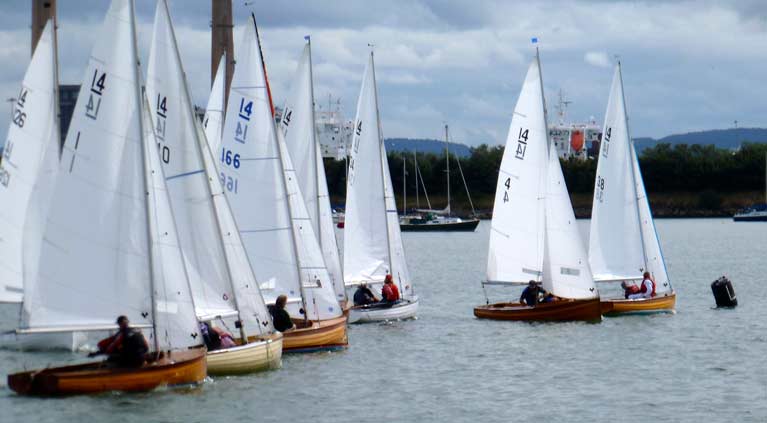 A spectator-friendly start for the IDRA 14s at Clontarf for their 70th Anniversary Race in 2016 in an area which dries out at low water. The line had been set from the shore to give a slight disadvantage to starboard tack boats, but a sudden backing of the light breeze accentuated this. Nevertheless the start proceeded, and while Andy Sargent in Dusk (no 4) has pulled off the port tack start, Gerry Sargent in Starfish is just able to make the pin on starboard, and he went on to win with Dusk second. Photo: W M Nixon
A spectator-friendly start for the IDRA 14s at Clontarf for their 70th Anniversary Race in 2016 in an area which dries out at low water. The line had been set from the shore to give a slight disadvantage to starboard tack boats, but a sudden backing of the light breeze accentuated this. Nevertheless the start proceeded, and while Andy Sargent in Dusk (no 4) has pulled off the port tack start, Gerry Sargent in Starfish is just able to make the pin on starboard, and he went on to win with Dusk second. Photo: W M Nixon
So anyway, after one particularly exasperating Race Week when the Organising Committee had insisted the Race Officer set the start line well away from harbour or any land, meaning we spent half the day getting there and back, I used the grapevine of the club bars to air an idea about a race among like-minded souls which would involve no Race Officer, and for its marks would rely only on islands (of which we have more than most folk realize in the Greater Dublin area), and on the navigation buoys of Irish Lights and Dublin Port.
Admittedly its successful functioning was reliant on inter-boat VHF, but for some years on the second Saturday of May, a handy flotilla of proper cruiser-racers in the 35-40ft range would get together for what we called The Islands Race in the morning sunshine (of course the sun always shone), and we’d talk ourselves into a sort of line and race round an island or two and a hefty steel buoy or three and end up somewhere agreeable like Skerries if the tide was right, or Poolbeg (when we ran up the Liffey under spinnaker right under the Hailing House to avoid the tide - you definitely couldn’t do that nowadays) or into Dun Laoghaire and an entertaining call to one of the clubs, or the Howth section might make the effort and get across to Dun Laoghaire and we’d all talk ourselves into a race back to Howth, maybe going round Dalkey Island and perhaps Ireland’s Eye on the way.
 The coastline of Greater Dublin is well blessed with convenient islands and other fixed turning marks
The coastline of Greater Dublin is well blessed with convenient islands and other fixed turning marks
It was perfect. But it was too good to last. Crews were returning home much too clearly demonstrating that they’d been having a lovely time. And the main official programme was expanding to spread into the shoulders of the season, taking up those early-May Saturdays, with Tim Goodbody in the Royal Alfred YC developing the season-long Superleague for cruiser-racers, which inevitably became a must-do series.
Our little idea lasted maybe half a dozen years. But with some people trying to make it more structured, while others who didn’t really fit the mould wanting to join, it was gently let go as we observed much-loved straightforward events such as the traditional Lambay Race degenerating into a cat’s cradle of windward starts and additional marks which confused simple mariners who knew very well indeed how to race round islands, but couldn’t get too excited about VMG towards some distant artificially-planted buoy.
For inevitably, the business of starting and running yacht races was becoming a mini-industry within itself, a mini-industry whose functioning adds to the time spent in actually getting in a decent little race which should be over and done with from about a quarter of an hour after leaving port, to within minutes of finishing.
It is something which is causing concern throughout sailing, but before we attempt a truly disruptive revolution and try to Make Sailing Simple Again, may I take another slight diversion?
For I have long wished to declare that the greatest benefactor of the human race is the inventor of golf. The thinking behind such a notion is this: What on earth would all those people be doing if they didn’t have golf to play? It helps to keep them moderately fit, and though it may result in artificially green spaces, from seaward or up in the hills an artificially green space in pleasant countryside is infinitely preferable to industrial or urban sprawl.
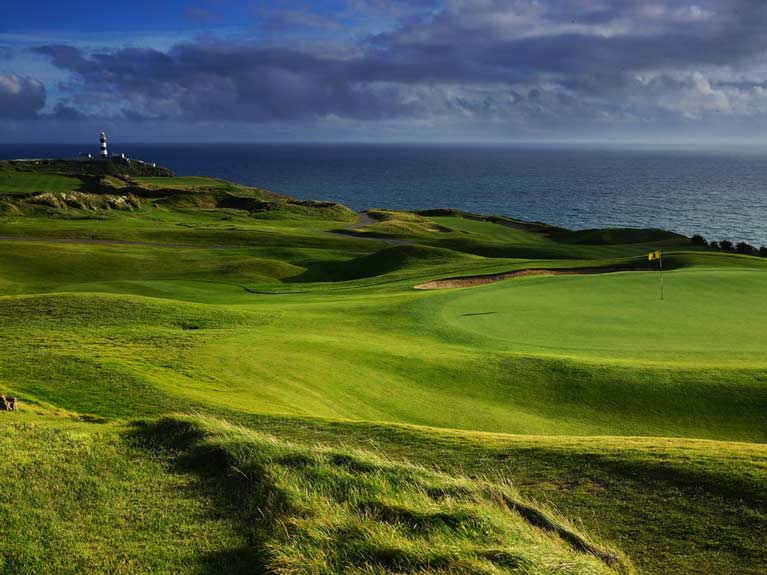 The Old Head Golf Course near Kinsale – it may be very artificially green, but it is preferable to industrial or urban sprawl
The Old Head Golf Course near Kinsale – it may be very artificially green, but it is preferable to industrial or urban sprawl
As for the people for whom golf is pleasantly sedating, they cause trouble to no-one. An experienced hotelier in the west of Ireland once told me that the golfer is the perfect guest, easily pleased if you’ve the proper hospitality skills, and no trouble to anyone. He or she will return to the inn in a relaxed frame of mind after one or two rounds of their beloved game, and for dinner they’ll invariably have a steak with a bottle of red wine. Then they’ll retire peacefully to their rooms maybe with another bottle or a pint of Guinness, and there they’ll settle down in bed and watch a golf video before sleeping serenely.
It’s an entire segment of society kept content with a sense of purpose. So when the disruptors talk of doing away with distantly-located “perfect” start lines and Race Officers who will not let the fleets away until a dozen wind requirements are fully met, do they (the disruptors) not have enough humanity in them to think about what might become of the not-inconsiderable corps of volunteers who currently man committee boats and back-up RIBs and mark boats and heaven only knows what else that floats and can usefully be deployed to ensure that a smaller number of people actually get in some sort of race?
For the fact of the matter is, a fully-crewed and effectively-equipped and properly-organised Committee Boat with its various support boats is arguably a floating Men’s Shed (and yes, I know there are many splendid women involved too, God bless them).
So if we go back to simple shore-based starts using transits as Nature intended rather than having fully-manned boats bobbing about at sea, what on earth is going to become of those who have been called to Committee Boat service? For it’s not for everyone – it’s a sort of secret society, and there’s an invisible vetting process.
Either way, if we just pack a race officer into a little pier-end hut with a time-keeper and a records secretary and set up the transits for a reasonable start and then let the sailors at it within a few yards of the harbour mouth, we’re inevitably going to cast all those Committee Boat folk, mark buoy boys, and umpires into a sort of purposeless outer darkness.
Perhaps they can take up golf…..Meanwhile, before this column is swamped into obliteration under an onslaught of Olympic Sailing Purity of Opinion, let it be pointed out that the Round Ireland Race starts from a shoreline, though admittedly with the race officer at the outer end in a Naval Service vessel if there’s one available. Elsewhere, much of Cowes Week and all of the Fastnet Race starts from a fixed shoreline. And as for the course, that’s then sailed, very little of it is round artificial marks other than established navigation buoys.
 Crazy but it works – the start of the Round Ireland Race 2014 as seen from the Wicklow pierhead
Crazy but it works – the start of the Round Ireland Race 2014 as seen from the Wicklow pierhead
And for those who object to racing where the effect of land regularly intrudes, just remember that the most popular participant sailing events in the world are the Round the Island Race around the Isle of Wight in the south of England, and the Round Gotland Race and other huge events involving close inshore stuff on islands in the Baltic.
Clearly, it’s what people want. And as for fancy Olympic courses in slightly remote area (ie more than two miles away from the harbour), they’re now soooo yesterday……Club sailors want convenience. If they want to go for a sail, they’ll simply go for a sail. But if they want a race, they don’t want to have to go for a sail before it. They want racing, and they want it now.
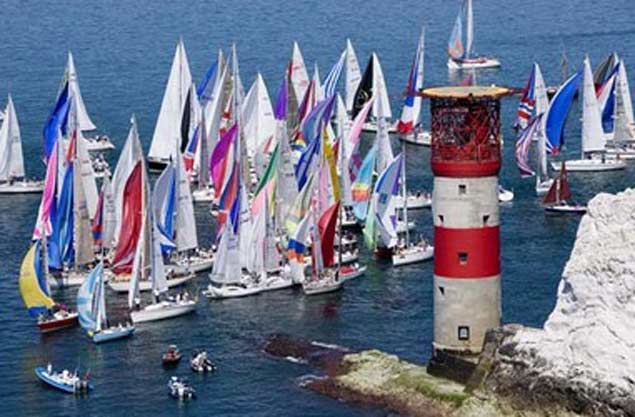 It’s sailing sport of a kind, but definitely not Olympic – the fleet in the Round the Island Race at the Needles, were those really cutting the corner have to be sure they pass safely inside the remains of a hidden shipwreck……
It’s sailing sport of a kind, but definitely not Olympic – the fleet in the Round the Island Race at the Needles, were those really cutting the corner have to be sure they pass safely inside the remains of a hidden shipwreck……
For a while, the ancient Howth 17s were told that the only racing that could be provided for them on a Saturday afternoon would be with the Puppeteer 22s (which carry an outboard auxiliary engine) at a Committee Boat start north of Ireland’s Eye in a supposedly clear area.
Yet if a calm fell, the Seventeens had to resort to a long oar, which was and is brutal to row with, and that’s it. So they rebelled, organized their own Race Officer rota for starts at the old pierhead line which they could reach within minutes from their moorings, and they’ve never looked back since. Saturday afternoon racing is the highlight of the week. So maybe if sailing organisers went by the old dictum of the customer being king, we might see club sailing becoming more healthy.
Here’s a vid of the Round the Island Race which usually starts at an ungodly hour of the morning, yet if you have a handy berth in the outer reaches of Cowes Harbour, you can leave it with just a quarter of an hour to go to your start. We’re not recommending that, but it can be done……
And as for those who like to claim that their nearest “clear area” really does minimize the need for local knowledge almost completely, let us remember the time when John Bertrand, America’s Cup-winning helm for Australia in 1983, finally achieved his true goal in life – becoming Etchells 22 World Champion in 2010, when it was staged in Howth.
For sure, the race area was set in the “clean zone” well clear of Howth, northwards between Ireland’s Eye and Lambay. But despite that, John Bertrand – whose crew for the big event was to include Tom Slingsby – spent six weeks (repeat: 6 weeks) in Howth beforehand, sailing his Etchells 22 morning, noon and night in the race area in order to get a complete feel for it and its many moods. He certainly deserved to win. But a bit of old-fashioned racing using a clear transit-marked shore-based starting line might have been more fun.
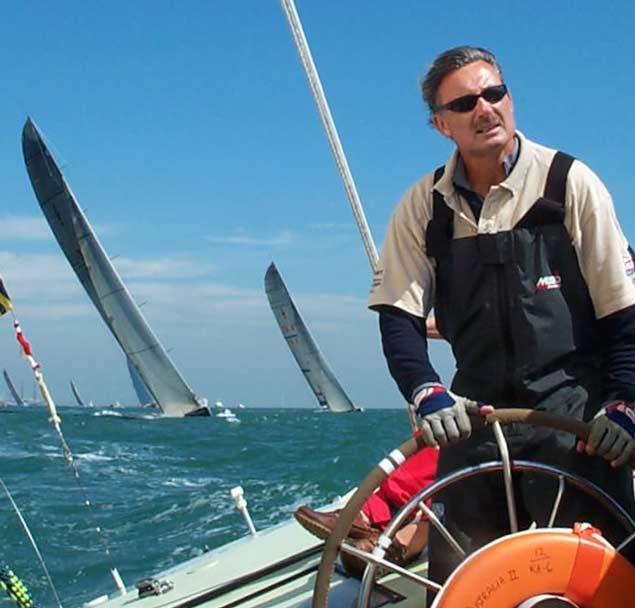 John Bertrand of Australia, who wrested the America’s Cup from the USA in 1983 for the first time since they originally won it in 1851. In 2010, he spent several weeks familiarizing himself with the “clear zone” sailing area off Howth before he raced on it to win the Etchells 22 Worlds
John Bertrand of Australia, who wrested the America’s Cup from the USA in 1983 for the first time since they originally won it in 1851. In 2010, he spent several weeks familiarizing himself with the “clear zone” sailing area off Howth before he raced on it to win the Etchells 22 Worlds
Ireland’s Eye Snapped Up By Investment Group
Howth’s iconic Ireland’s Eye has been purchased by investment group Tetrarch Capital, TheJournal.ie comfirms.
The island — which is an important breeding spot for many seabirds — was included in the recent sale of Howth Castle and demesne by the Gaisford-St Lawrence family, whose ancestors held the lands since the 12th century Norman invasion.
The new owners say visitors are still “very welcome to the island” and boat trips will continue to be offered by local operators.
“It is our intention to work closely with key stakeholders to preserve the beauty, amenity and accessibility of Ireland’s Eye,” a spokesperson for Tetrarch Capital said.
Tetrarch Capital’s portfolio includes Kilkenny’s Mount Juliet Estate, hotels at Citywest and Powerscourt, and a number of development sites in Dublin city centre.
Howth Harbour Is Getting Its Own Seabin Next Week
A campaign to raise funds for Howth Harbour’s first Seabin has been successful, and the first device will be switched on at a special event next Wednesday morning (21 August).
Earlier this year, local man Rowan Byrne launched a crowdfunding drive to pay for the installation of the surface water cleaning device that has already made a big difference in Dun Laoghaire thanks to the sterling efforts of young marine litter campaigner Flossie Donnelly.
Byrne has also been backed by his employer Mott MacDonald and Howth’s Harbour Master in his own efforts, and harbour authorities will maintain the Seabin that will be installed at the passenger vessel ferry pontoon opposite Aqua restaurant.
The Seabin is essentially a floating bucket with a pump that sucks in debris from the surface and traps it for later collection.
But the device’s simplicity belies its effectiveness, as a single Seabin as the potential to collect as many as 20,000 plastic bottles or more than 80,000 plastic bags from the water each year.
“Everyone knows just how important the sea and the marine life in there is to us,” said Harbour Master Harold McLoughlin. “We hope this Seabin will have a big impact on the amount of rubbish floating around in the local area.”
































